Year5/Oral surgery II/Dr.Chhiv Eang seng/1-50
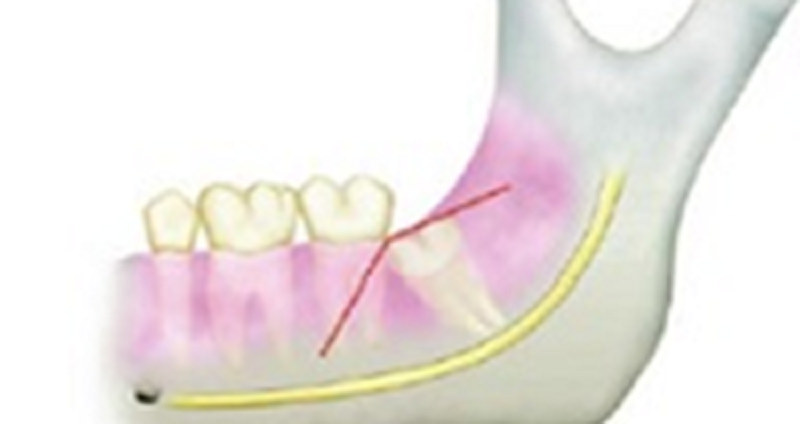
1. What is the name of this flap?
σ� Triangular flap
σ� Envelope flap
σ� Three sided fap
σ� All are not corrects
2. There are only 2 ways to surgically remove a tooth?
σ� Make the socket bigger or make the tooth smaller
σ� Use elevator or use forceps
σ� Use elevator and make tooth smaller
σ� All are correct
3. Diagnosis Definition?
σ� A judgment about what a particular illness is, made after examining it
σ� The process of differentiating between two or more conditions which share similar signs or symptoms
σ� A doctor's judgment of the likely or expected development of a disease or of the chances of getting better
σ� All are not correct
4. Differential diagnosis definition?
σ� The process of differentiating between two or more conditions which share similar signs or symptoms
σ� A doctor's judgment of the likely or expected development of a disease or of the chances of getting better
σ� A judgment about what a particular illness is, made after examining it
σ� All are not correct
5. On panoramic radiograph, cysts appear as?
σ� Radiolucent (dark) areas with radiopaque (white) borders
σ� Radiopaque (white) areas with radiolucent (dark) borders
σ� Radiopaque (white) with radiolucent (dark) areas
σ� All are not correct
6. Normal characteristics of dental cyst?
σ� All are correct
σ� The exact diagnosis of the type of cyst is often made from pathological examination
σ� Fluid aspirated from a radicular cyst may display shimmering due to cholesterol content
σ� Cysts are usually unilocular, but maybe multilocular
7. Normal characteristics of peri-apical dental granuloma?
σ� All are correct
σ� Could be confused with radicular cyst or periapical abscess
σ� Usually round or oval with a distinct border
σ� Radiolucency found at the apex of a tooth with chronic inflammation
8. Prognosis definition?
σ� A doctor's judgment of the likely or expected development of a disease or of the chances of getting better
σ� The process of differentiating between two or more conditions which share similar signs or symptoms
σ� All are not corrects
σ� A judgment about what a particular illness is, made after examining it.
9. Normal Oxygen Saturation rate?
σ� 96% - 99%
σ� 93% -98%
σ� 94% - 98%
σ� 98% - 99%
10. Normal value for International Normalized Ratio?
σ� 0.8 – 1
σ� 0.5 – 1
σ� 0.6 – 1
σ� 0.7 – 1
11. Normal temperature rate?
σ� 36.5 ͦ C -37.5 ͦ C
σ� 35.5 ͦ C -38 ͦ C
σ� 36 ͦ C -38 ͦ C
σ� All are not correct
12. Accurate diagnosis needs?
σ� All are correct
σ� Special test
σ� Clinical examination
σ� Case history
13. Indications for surgical extraction of a tooth?
σ� Tooth with unusual root morphology and hypercementosis of root
σ� Multiple roots
σ� Hypercementosis of root
σ� Tooth with unusual root morphology
14. Contra-indications for surgical extraction of a tooth?
σ� All are correct
σ� Older patients with a risk of serious local complication (injury of the alveolar nerve)
σ� Older patients with a risk of serious local complication (the dislodging of a root tip into the maxillary sinus)
σ� There are serious health problems present such as uncontrolled diabetes
15. Palpation areas of lymph nodes are?
σ� All are correct
σ� Deep cervical
σ� Sub-mandibular
σ� Sub-mental
16. The sensation feeling when doing palpation are?
σ� All are correct
σ� Fixed
σ� Mobile
σ� Tender
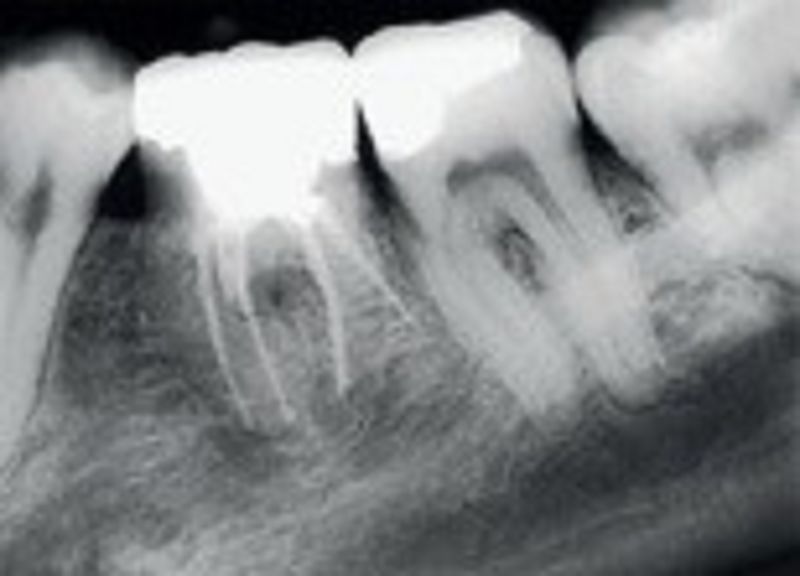
17. The below picture showed?
σ� Ankylosed roots
σ� Hypercementosis of roots
σ� Unusual root morphology
σ� All are correct
18. Temporomandibular joint disorder sign and symptoms?
σ� All are correct
σ� Clicking noise
σ� Mouth opening limitation
σ� Tenderness
19. Vertical percussion (Tender/not tender)?
σ� Peri-apical periodontitis and peri-apical granuloma
σ� Periodontal pathology (abscess)
σ� Peri-apical periodontitis, peri-apical granuloma and periodontal pathology (abscess)
σ� All are correct
20. Horizontal percussion (Tender/not tender)?
σ� Periodontal pathology (abscess)
σ� Peri-apical periodontitis, peri-apical granuloma and periodontal pathology (abscess)
σ� Peri-apical periodontitis and peri-apical granuloma
σ� All are correct
21. Intra-oral examination of soft tissue?
σ� All are correct
σ� Uvula and tonsil
σ� Lip, palatal mucosa, and oropharynx
σ� Buccal mucosa, floor of the mouth, and tongue
22. The extraction of root tips should not be considered, especially in older patients, when?
σ� All are correct
σ� There are serious health problems present
σ� There is a risk of a root tip into the alveolar nerve
σ� There is a risk of a root tip into the maxillary sinusZ
23. Clinical factors predicting extraction difficulty?
σ� All are correct
σ� Excessively strong supporting tissues
σ� Inadequate access
σ� Impacted teeth
24. Radiographic factors predicting extraction difficulty?
σ� All are correct
σ� Close to vital structure
σ� Multiple roots
σ� Accessory roots
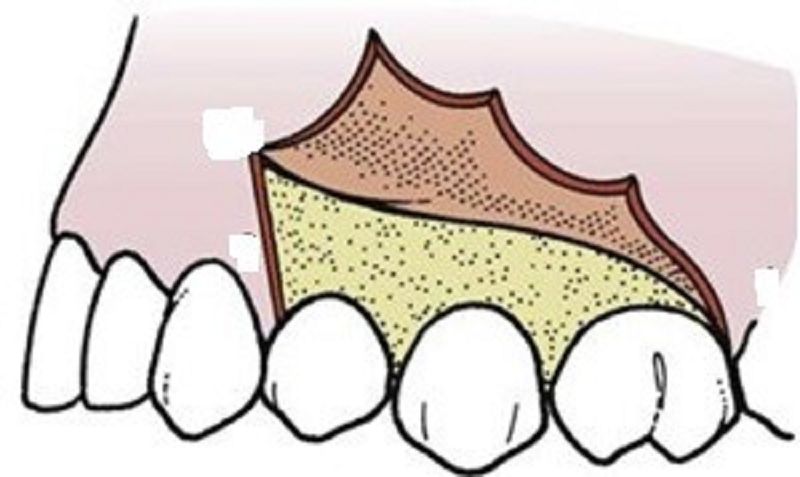
25. What is the name of this flap?
σ� Two-sided flap
σ� Three sided fap
σ� Triangular flap
σ� Envelope flap
26. Flap design features?
σ� All are correct
σ� Avoid important structure
σ� Adequate size
σ� Broad base
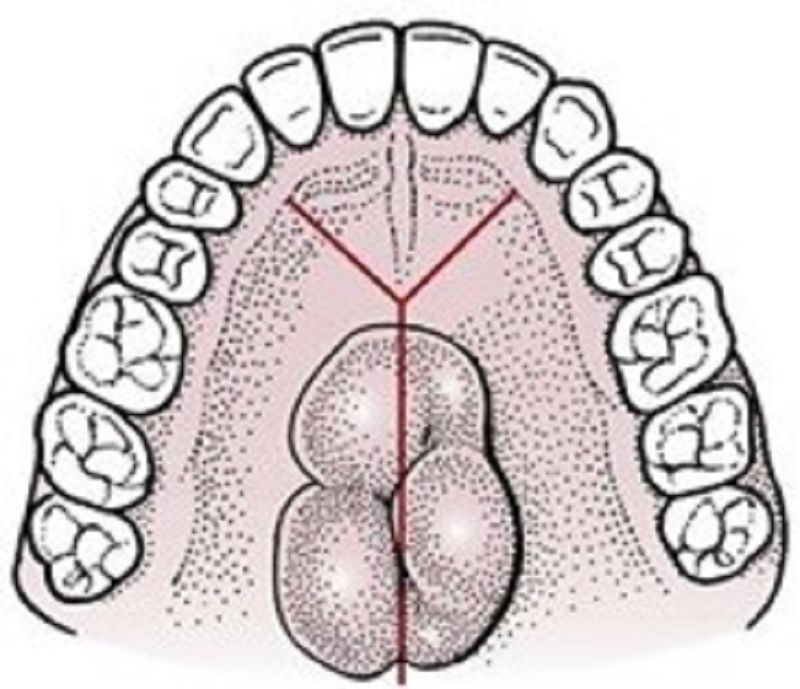
27. What is the name of this flap?
σ� Y flap
σ� Full thickness flap
σ� X flap
σ� Three-sided flap
28. The main flaps for lower third molar?
σ� All are correct
σ� Triangular flap
σ� Three-sided flap
σ� Envelope flap
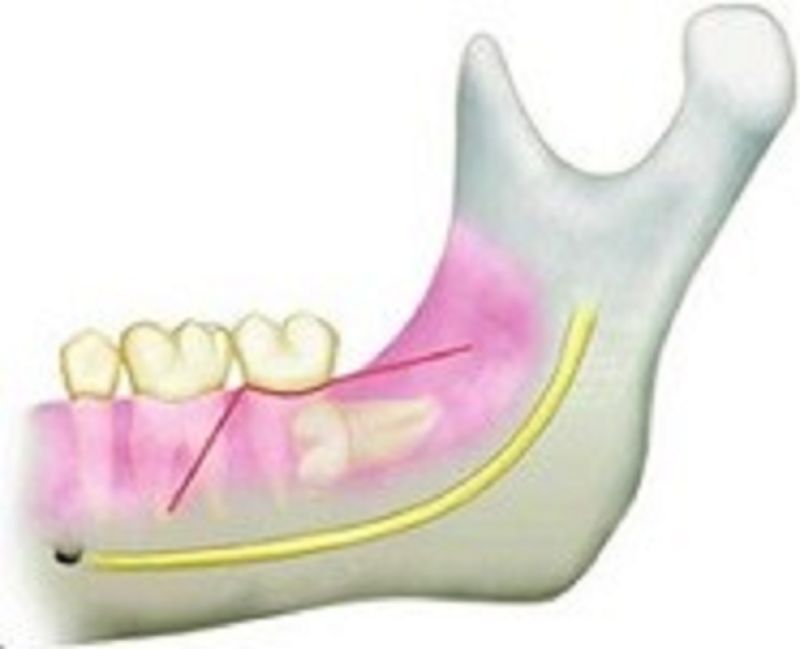
29. What is the name of this flap?
σ� Three sided fap
σ� Triangular flap
σ� Envelope flap
σ� Four sided flap
30. If a nearby tooth was unintentionally luxated, the tooth should be stabilized for approximately?
σ� 40 – 60 days
σ� 20 – 40 days
σ� 60 – 80 days
σ� 60 – 90 days
31. If a nearby tooth was unintentionally dislocated, the tooth should be repositioned and stabilized for approximately?
σ� 3 – 4 weeks
σ� 2 – 3 weeks
σ� 4 – 5 weeks
σ� 5 – 6 weeks
32. Important anatomical structures to be avoided?
σ� All are correct
σ� Arteries
σ� Sinus
σ� Nerves
33. The main means of arresting bleedings are?
σ� All are correct
σ� Use of various hemostatic agents
σ� Ligation and suture
σ� Compression
34. A tooth or root fragment could be displaced into?
σ� All are correct
σ� Under periosteum
σ� Lung
σ� soft tissue
35. Cut releasing incisions to avoid cutting through the mental nerve?
σ� Cut releasing incisions mesial of the 4 or distal of the 6
σ� Cut releasing incisions mesial of the 5 or distal of the 6
σ� Cut releasing incisions mesial of the 4 or distal of the 5
σ� All are correct
36. Oro-antral communication could be examined by?
σ� All are correct
σ� Bubble and sound come out from the hole
Valsalva Method
σ� Fluid come out of the nose when drinking
37. For lower wisdom tooth surgery, the incision must go towards the disto-buccal to?
σ� Avoid cutting the lingual nerve
σ� Avoid cutting the inferior alveolar nerve
σ� Avoid cutting the long buccal nerve
σ� All are correct
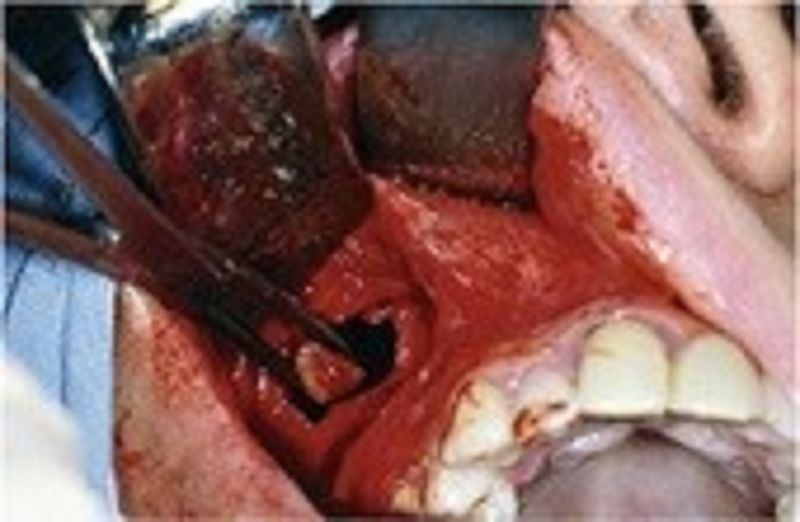
38. What is the name of below technique?
σ� Caldwell-Luc Technique
σ� Lateral window technique
σ� Semilunar incision technique
σ� Two-sided flap
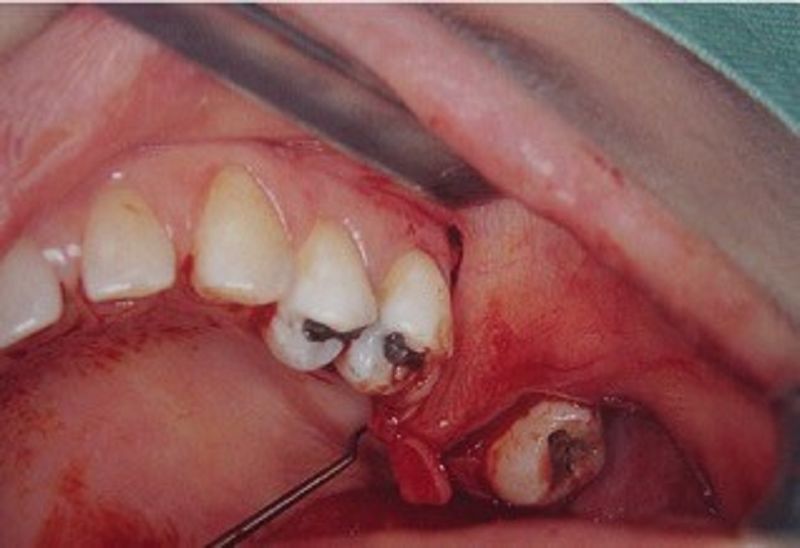
39. What is the name of this flap?
σ� Vestibular flap
σ� Triangular flap
σ� Two-corner-flap
σ� Three-sided flap
40. The most common nerve injuries are?
σ� All are correct
σ� Lingual nerve
σ� Mental nerve
σ� Inferior alveolar nerve
41. Delay wound healing is due to?
σ� Interrupted stroke of incision
σ� During the incision, the scalpel is in constant contact with bone
σ� A flap releasing stays sub-periosteum
σ� A firm continuous stroke of incision
42. A good incision should avoid?
σ� All are correct
σ� Through the inter-dental papillae
σ� Cross the attached gingivae directly over the facial aspect of a tooth
σ� Cross the canine eminence
43. Neurapraxia means?
σ� Temporary nerve conduction failure
σ� Degeneration of nerve axons
σ� Formation of scar tissue
σ� Permanent nerve conduction failure
44. Third molar surgical swelling reaches a maximum within?
σ� 48 – 72 hours post-operatively
σ� 24 – 48 hours post-operatively
σ� 96 – 120 hours post-operatively
σ� 72 – 96 hours post-operatively
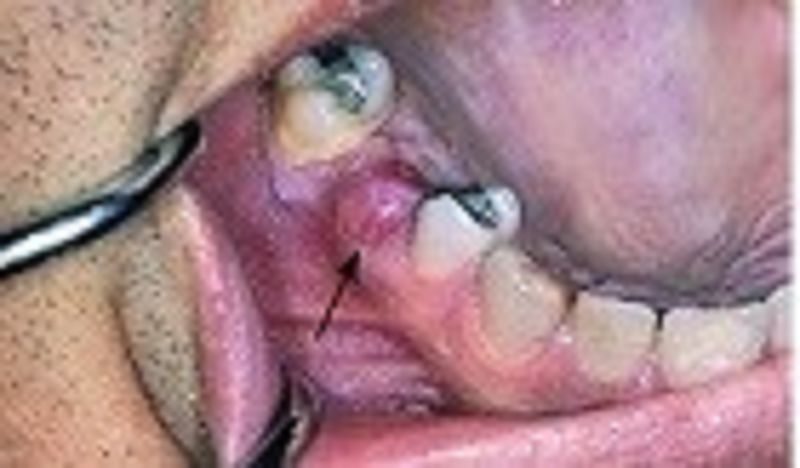
45. What is it called?
σ� Liver clot
σ� There are corrects
σ� Infection
σ� Hematoma
46. Fibrinolytic Alveolitis characteristic?
σ� All are correct
σ� Severe pain
σ� Fetid breath odor
σ� Empty socket
47. Which one is wrong about treatment of dry socket?
σ� Prescribe antibiotics
σ� There are corrects
σ� Irrigate with saline to remove food debris
σ� Place a sedative dressing such as Alvogyl (contains iodine)
48. Intermediate hemorrhage?
σ� Refers to bleeding that occurs within 24 hours of surgery
σ� Occurs after 24 hours of surgery
σ� There are corrects
σ� Occurs during the time of surgery
49. Goal of suturing?
σ� All are correct
σ� Maintain hemostasis
σ� Prevent bone exposure
σ� Provide support for tissue margin
50. Plain catgut suture absorption time?
σ� 40 – 60 days
σ� 20 – 40 days
σ� 60 – 80 days
σ� 80 – 100 days
{"name":"Year5\/Oral surgery II\/Dr.Chhiv Eang seng\/1-50", "url":"https://www.quiz-maker.com/QPREVIEW","txt":"1. What is the name of this flap?, 2. There are only 2 ways to surgically remove a tooth?, 3. Diagnosis Definition?","img":"https://www.quiz-maker.com/3012/CDN/91-4429940/zxz.png?sz=1200-00000021340992205300"}
More Quizzes
WNT//HAMZA MRIAN//كويز في وحدة البيئة والعنف الجامعي
36180
The Peepers Quiz- Ladies Edition
10512
Weather and atmosphere final
51260
Religion
8442100
How Well Do You Know Majora's Mask? Take the Keaton!
201048403
How Well Do You Know Rico From the Movie Belly?
201023969
Discover Which Dumbo Character You Are - Free
201025695
Is It Cheating Questions: Are You a Loyal Partner?
201031401
Ultimate Hunger Games Trivia: Test Your Panem Knowledge
201046427
Free [Topic] Knowledge Assessment
201025934
Bees in Greek Mythology: Challenge Your Knowledge
201065809
Advanced Cement Chemistry
15825463